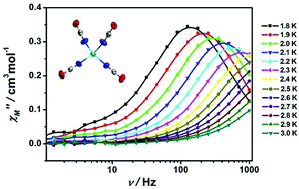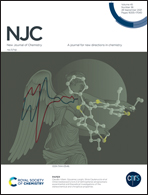Magnetic anisotropies and slow magnetic relaxation of three tetrahedral tetrakis(pseudohalido)–cobalt(ii) complexes†
Abstract
Three mononuclear tetrakis(pseudohalido)-cobalt(II) complexes (Ph4P)2[Co(E)4] (E = N3−, 1; NCO−, 2; NCS−, 3) have been synthesized and structurally characterized. Each compound contains a distorted tetrahedral Co2+ ion coordinated by four pseudohalide ligands. The magnetic properties of 1–3 have been studied using direct-current magnetic measurements and high-frequency and -field EPR spectroscopy (HFEPR), suggesting easy-axis magnetic anisotropy for 1 and 2 and easy-plane anisotropy for 3. Analysis of the HFEPR spectra yielded D values of −5.23 and +3.63 cm−1 for 2 and 3, respectively. The absence of the EPR signal in 1 is consistent with a large, negative value of the zero-field splitting (ZFS) parameter D in 1. The nature of magnetic anisotropies of 1–3 has also been confirmed by ab initio calculations. The calculated D values are consistent with those determined using magnetometry and HFEPR studies. Alternating current (AC) magnetic susceptibilities reveal slow magnetic relaxation under an applied magnetic field, thus indicating that 1–3 are field-induced single-ion magnets (SIMs).



 Please wait while we load your content...
Please wait while we load your content...